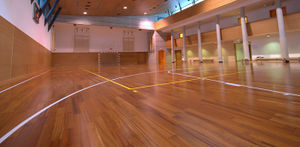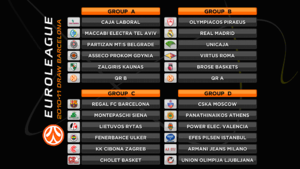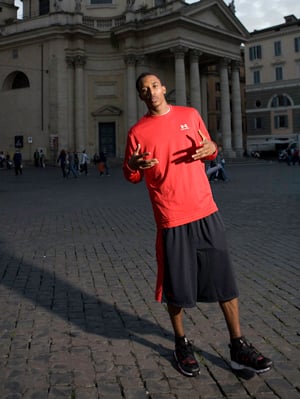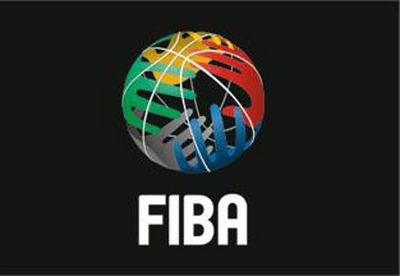
The International Game Now imagine the hardwood floor that just got waxed squeaky clean and you can just see your reflection clearly. Let’s not forget those fresh shoes with the new car smell ready to be laced up. The players that are running sprints up and down the court to have their legs warmed up. The crowd is screaming their hearts out for their favorite player every single individual is passionate about their team and roars to show whose team is the winning side. And to think FIBA (The International Basketball Federation) isn’t looked at as competitive compared to the NBA (National Basketball Association). Every player has their own ritual of getting in the “mode”. For example, Kobe Bryant for the Los Angeles Lakers shows up to the Staples Center three hours prior to game time. His motive for this is to get some shots up and make sure mentally his head is in the game. The mode to any player is the motivational point to help them focus on the game. The less distractions means the better the player perform on the hardwood floor. In this paper I will discuss what the NBA season is about as well the FIBA season. How the NBA playoffs system works compared to the FIBA league playoffs. How the FIBA league got started. I will also touch on how competitive the FIBA league is. Also, I will discuss the hardships of culture shock that American player Brandon Jennings went through while being overseas using the U- curve chart. Also how retired NBA player Yao Ming made his transition with culture shock to America. I will touch on the re-entry shock experiences Yao endured using the Re-Entry W-Curve."
The Basic Numbers

How many folks do you know that wants to make it to the NBA league? According to Scoop Jackson a sports writer for ESPN “Page 2” less than one percent makes it pro. The exact percentage of this is .03 three out of every 10,000 male high school player will be drafted into the NBA. And that’s not even counting the foreign players that want to join the NBA league. The strongest international basketball league is the Euroleague. There are other basketball leagues in Europe such as Eurocup, Adraitic League, VTB, and League. The Euroleague is considered the European equivalent of the NBA. It consists of 24 teams, with playoffs and a championship. The best players in Europe play in this league and the NBA heavily scouts it. There are about 350 players in the league roughly. Now, 85 percent of them are African Americans so we can say that there are about 300 players that are African American professional basketball players. Does this mean the league only has the top 350 players in the world who are more competitive than anybody else? Those who don’t end up making it to the NBA league after college or just trying out for a team workout go play international."
Simply Brandon International countries recruit heavily especially if the player was a star in college but just didn’t have it took to make it in the NBA league. The reason for them recruiting in the United States they know there are competitors that won’t get the chance to play in the NBA but still can compete at a high level. For example, Brandon Jennings of the Milwaukee Bucks skipped college and went straight overseas in order to gain experience on the international level and low scoring academic abilities to get into a four year college.. In the article “Exchange Student” by Chris Broussard he asked him what were the difficulties of living overseas? “Everything is tiny. The bed looks like it could be palmed by Shaq. The room is the size of a Hummer. The hotel looks like a town house.” It doesn’t sound too pleasant from the sound of it. But, in order to compete at the highest, one must experience difficulties. Although, the NBA had already changed the rules about entering from high school; Brandon was persistent to make it professional. Andrew Bynum of the Los Angeles Lakers was the last player to enter into the league after high school back in 2005. The NBA commissioner David Stern stated in a post conference interview led by Ryan Ward “With this rule, no players are allowed to come directly out of high school straight to the pros.” When this rule came into action, players would end up going overseas, playing in the D-League, and going to college. With that being said Brandon Jennings headed to Folgaria, a pristine little ski village high in the mountains of northern Italy. In order to make a name for himself to be a potential draft pick for the NBA he made sure that his hard work would pay off. Brandon also stated “This sure ain't LA. It’s culture shock and a hoops reeducation to boot. "It's tough, I'm not going to lie," says Jennings while eating pizza between practices. "I don't see many kids coming over here to do this. All that stuff about trendsetting? I don't know about that. You really have to be mentally tough."

The History Behind the FIBA League Let’s take a closer look at the FIBA league. After several failed attempts to establish an independent international federation for just basketball, the first International Basketball Conference (FIBA) was held June 18, 1932. According, to the “IAHF Technical Commission for Basketball” at the first conference the FIBB league was formed with eight national basketball associations among the original founders of FIBB -- Argentina, Czechoslovakia, Greece, Italy, Latvia, Portugal, Romania and Switzerland. Many of the players in the league are international. At an extraordinary rate the competition began to grow and became recognized even by the NBA (National Basketball Association). However, the United States didn’t get added to the league until late 1934. When the FIBA league started gaining more popularity, the countries Austria, Belgium, Egypt, Estonia, France, Germany, Poland, and Spain were added as well. Over the years the FIBA league is still growing with popularity with more passion than imagined from the fans that support the international game."
See also
- [[]]
- [[]]
- [[]]
Interwiki links
- Wikipedia:
- []
External links
- []
[[Category:]] [[Category:]]
